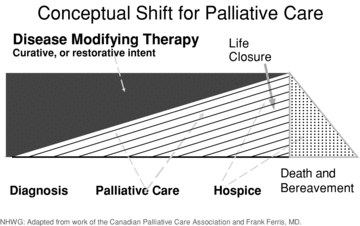Increased access to palliative care and hospice services: opportunities to improve value in health care
- PMID: 21933272
- PMCID: PMC3214714
- DOI: 10.1111/j.1468-0009.2011.00632.x
Increased access to palliative care and hospice services: opportunities to improve value in health care
Abstract
Context: A small proportion of patients with serious illness or multiple chronic conditions account for the majority of health care spending. Despite the high cost, evidence demonstrates that these patients receive health care of inadequate quality, characterized by fragmentation, overuse, medical errors, and poor quality of life.
Methods: This article examines data demonstrating the impact of the U.S. health care system on clinical care outcomes and costs for the sickest and most vulnerable patients. It also defines palliative care and hospice, synthesizes studies of the outcomes of palliative care and hospice services, reviews variables predicting access to palliative care and hospice services, and identifies those policy priorities necessary to strengthen access to high-quality palliative care.
Findings: Palliative care and hospice services improve patient-centered outcomes such as pain, depression, and other symptoms; patient and family satisfaction; and the receipt of care in the place that the patient chooses. Some data suggest that, compared with the usual care, palliative care prolongs life. By helping patients get the care they need to avoid unnecessary emergency department and hospital stays and shifting the locus of care to the home or community, palliative care and hospice reduce health care spending for America's sickest and most costly patient populations.
Conclusions: Policies focused on enhancing the palliative care workforce, investing in the field's science base, and increasing the availability of services in U.S. hospitals and nursing homes are needed to ensure equitable access to optimal care for seriously ill patients and those with multiple chronic conditions.
© 2011 Milbank Memorial Fund. Published by Wiley Periodicals Inc.
Figures
References
-
- AAHPM (American Academy of Hospice and Palliative Medicine) Fellowship Program Directory. Chicago: 2008.
-
- AAHPM (American Academy of Hospice and Palliative Medicine) Mid-Career Pathway. 2011. Available at http://www.aahpm.org/Train/default/midcareerpath.html (accessed May 8, 2011) - PubMed
-
- AAMC (Association of American Medical Colleges) Recent Studies and Reports on Physician Shortages in the U.S. 2009.
-
- AHRQ (Agency for Healthcare Research and Quality) Healthcare Cost and Utilization Project (HCUP): Hospitalization in the United States, 2002. 2002. Available at http://www.ahrq.gov/data/hcup/factbk6/factbk6c.htm (accessed August 5, 2009)
-
- American Board of Hospice and Palliative Medicine. ABMS Votes to Make Hospice and Palliative Medicine an ABMS Subspecialty. 2006.
MeSH terms
LinkOut - more resources
Full Text Sources
Medical


